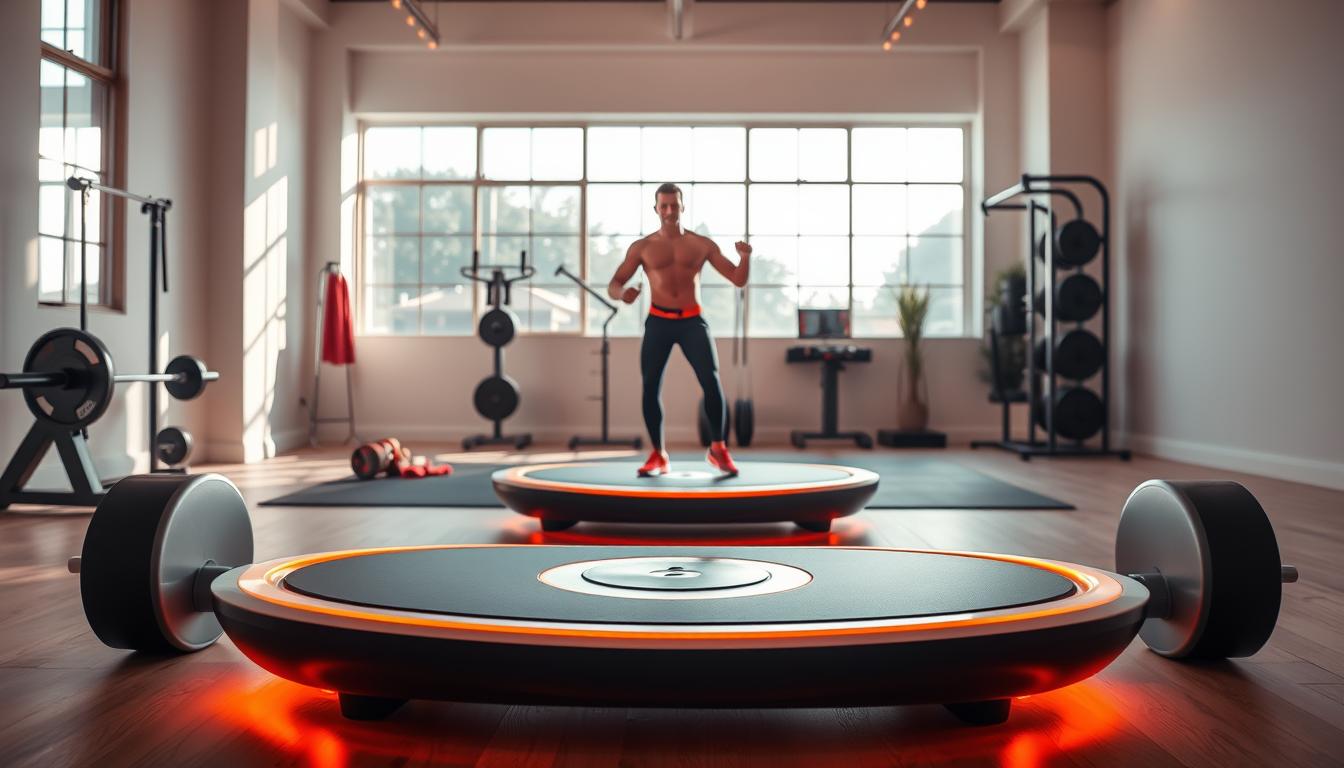Ever felt like your workouts hit a plateau? Imagine a tool that boosts your efforts, making every stretch or squat more effective. That’s what vibration plates do. They’re not just another gym gadget; they change how you think about fitness.
Whether you’re an experienced athlete or just starting, learning about what is a vibration plate could be a game-changer for you.
Imagine standing on a platform that vibrates gently. Your muscles start working automatically. This is the heart of vibration plate technology.
It improves balance and boosts muscle activation. Vibration plate benefits are changing fitness spaces everywhere. But how does it work? And can it help you reach your fitness goals?
Click here to get yours today.
Key Takeaways
- Discover how vibration plates enhance traditional workouts through mechanical stimulation.
- Learn the science behind vibration plate benefits like improved strength and flexibility.
- Understand the basics of what is a vibration plate and its role in modern fitness trends.
- Explore real-world applications, from recovery to weight loss support.
- Preview the article’s deep dive into choosing the right device and seeing results.
Introduction to Vibration Plate Technology
Vibration plate technology has become a key part of fitness today. It started in the 1960s with Soviet space programs to fight muscle loss in astronauts. Now, it’s used by athletes, rehab patients, and regular people for quick workouts.
The Evolution of Vibration Training
Research in the 1960s showed how vibration plates work to make muscles contract. By the 2000s, better technology and safety made them available for everyone. Studies in the Journal of Sports Sciences proved they’re effective.
How Vibration Plates Entered the Fitness Mainstream
Brands like Power Plate and Hypervolt made them easy to use. Fitness stars and celebrities talking about them helped more people try them. Now, gyms and homes use them for fast workouts, leading to 8% sales growth each year.
Types of Vibration Plates Available Today
| Type | Mechanism | Best Use |
|---|---|---|
| Linear | Vertical up/down motion | Strength training, balance exercises |
| Pivotal/Oscillating | Side-to-side rocking | Joint-friendly rehab, flexibility |
| Tri-Planar | 3D rotational movement | Full-body workouts, sports conditioning |
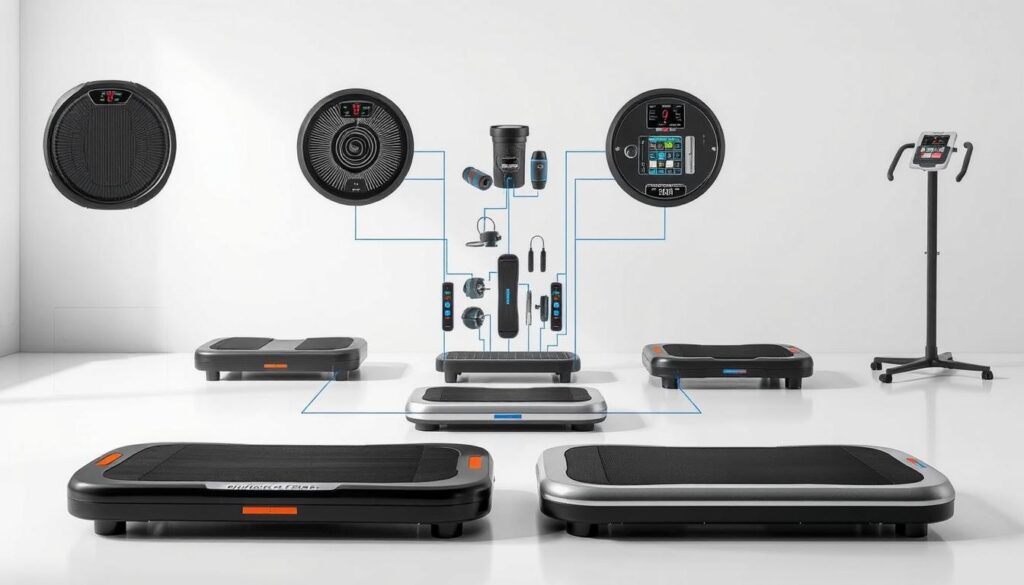
Each type has its own purpose. Linear plates are popular at home because they’re affordable. Tri-planar plates are used in professional settings. Knowing the difference helps pick the right plate for your goals.
What Is a Vibration Plate, and How Can It Help Me with My Fitness?
A what is a vibration plate is a motorized platform that shakes up and down fast. They come in different sizes and powers but all do the same thing. They send vibrations through your body when you stand or move on them.
The how vibration plate works is simple. Your muscles tighten and relax to keep balance with the vibrations.
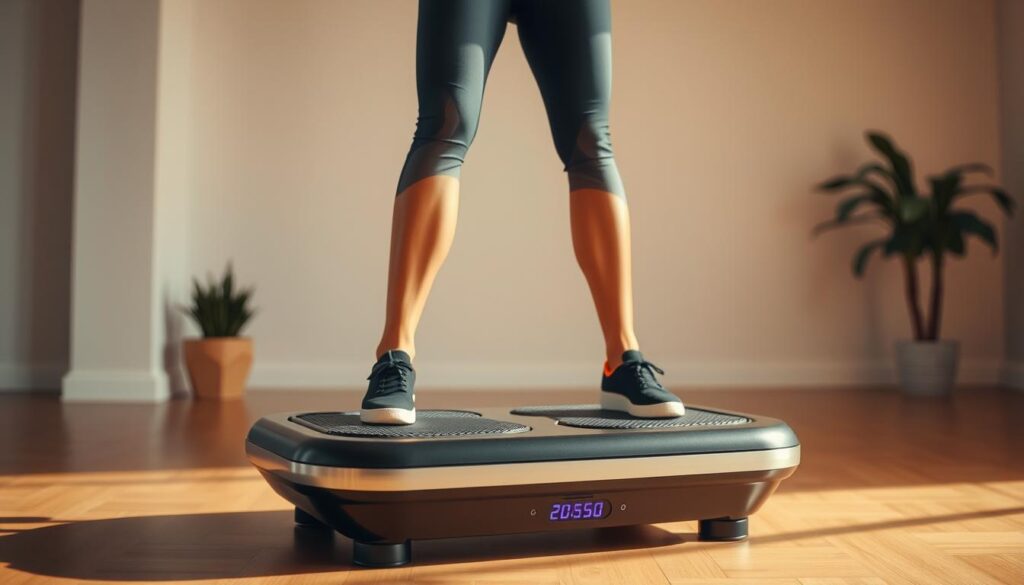
- Vibrations trigger reflexive muscle contractions up to 50 times per second
- Low frequencies (2-30 Hz) target muscle endurance
- Higher intensities boost calorie burn and strength gains
| Component | Function | Benefit |
|---|---|---|
| Vibrating Platform | Generates vertical motion | Engages 100+ muscles at once |
| Adjustable Intensity | Controls vibration speed | Suits beginners to athletes |
| Reflex Response | Muscles work without conscious effort | Efficient strength building |
These machines make your workouts better by improving balance and circulation. They also make your workouts more efficient. Even when you’re standing, your body is working hard. This makes how vibration plate works perfect for those who are short on time but want to stay fit.
The Science Behind Vibration Training
Vibration plate technology uses precise forces to change how our bodies work. Let’s dive into the science:
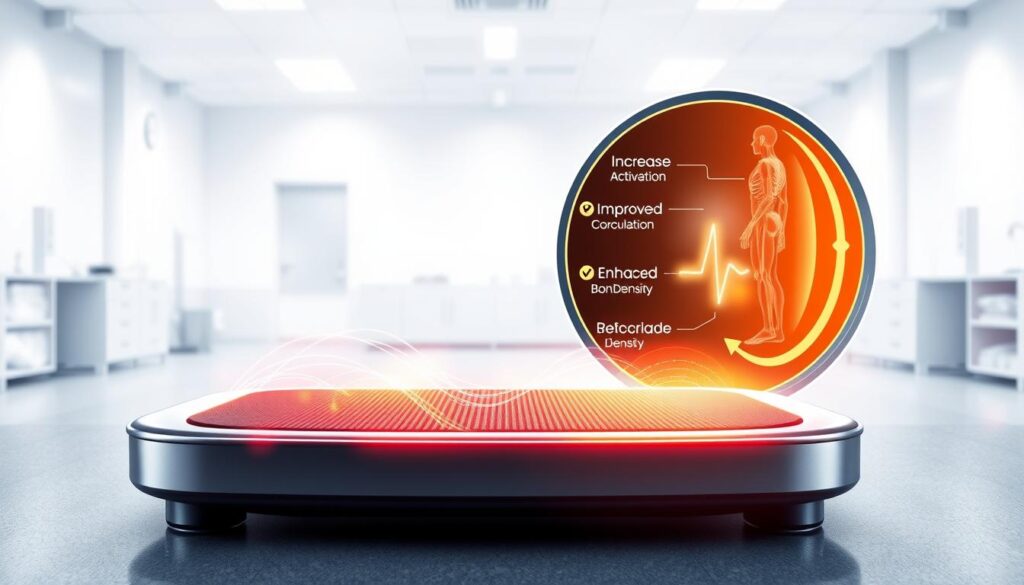
Understanding Mechanical Stimulation
Vibration plates make waves in hertz (Hz) and amplitude (mm). They usually go from 20–50 Hz. Higher frequencies make muscles work fast, while lower ones help with balance. Important things include:
- Frequency: Cycles per second that show how intense it is
- Amplitude: How far the plate moves
- Direction: Whether it moves up and down or side to side
How Your Body Responds
When you stand on the plate, your muscles contract up to 50 times a second. This leads to:
- Better blood flow to muscles
- More growth hormones released
- Stronger bones thanks to osteoblasts
“Even low-frequency vibrations can make muscles work 30% better than just standing,” says Dr. Emily Carter, a biomechanics researcher at Harvard University.
Research Findings
Studies show the vibration plate benefits are real. For example:
- A 2020 Nature Sports Science review found a 8% boost in metabolism after 20 minutes.
- A 2019 Clinical Physiology trial showed a 25% increase in lower-back strength after 12 weeks.
But, vibration plate results can differ based on fitness levels. It’s best to talk to trainers to get the right settings.
Top Health and Fitness Benefits of Vibration Plates
Vibration plates do more than just help you work out. They can really improve your health in many ways. They make muscles stronger, help with balance, and even improve blood flow and bone health. Let’s look at the main benefits users see.
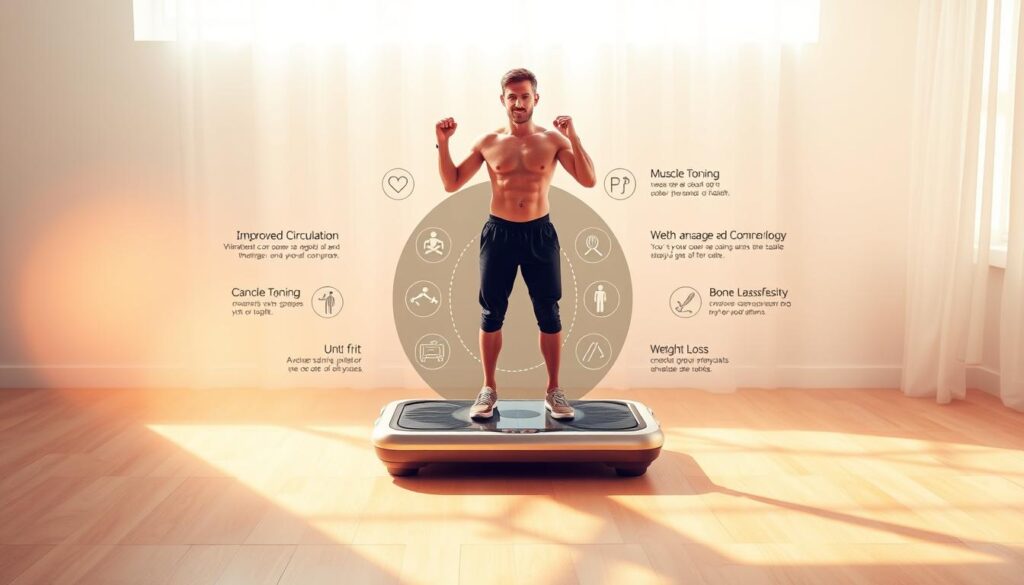
- Improved Muscle Tone: Short sessions make muscles contract and relax fast, which increases strength over time.
- Better Circulation: The vibrations help blood flow better, which means more oxygen gets to your body’s tissues and organs. Many people notice this effect in just a few weeks.
- Enhanced Balance: Standing on a vibrating plate makes it harder to stay steady. This helps improve coordination and lowers the risk of falls.
- Bone Density Support: Studies show that using these plates regularly can help keep bones strong, which is good for older adults.
- Flexibility Gains: The shaking motion helps loosen tight muscles, making it easier to move for people with limited mobility.
The results from using vibration plates vary. You might see better blood flow and more energy in just a few weeks. But, it takes 8-12 weeks of regular use to see muscle and bone density improvements. Flexibility and balance get better slowly but surely. The key is to keep using it regularly.
Before you start, it’s a good idea to talk to a fitness expert. The benefits of vibration plates are real, but they depend on your health and how you use them.
How Vibration Plates Support Weight Loss Goals
Vibration plates help with weight loss by making muscles work through fast vibrations. This action triggers the body to burn more calories and boost metabolism. They are best used as a supplement to diet and exercise, not a replacement.
Calorie Burning and Metabolic Effects
When you use a vibration plate, your body has to adjust to the vibrations. This makes muscles contract and relax over and over. It can make your heart beat faster and burn more calories.
Research shows that short sessions on a vibration plate can increase your metabolic rate by up to 10%. This helps with fat loss.

Combining Vibration Training with Traditional Methods
Using a vibration plate with cardio, strength training, or eating less can make results better. For example:
- Using the plate after working out can help burn more calories
- Adding it to a low-calorie diet can make losing fat more efficient
- Short 10–15 minute sessions fit well into busy lives
Real Results: What to Expect
“Vibration plate results are most noticeable when used consistently alongside other healthy habits.”
Results can vary. Most people see a small improvement, like a 2–5% drop in body fat in 8–12 weeks. It’s not a magic solution but a helpful tool for those serious about fitness.
Click here to get yours today.
Effective Exercises to Perform on a Vibration Plate
Boost your vibration plate workout with these focused vibration plate exercises. They are great for everyone, from beginners to pros. They help build strength, balance, and flexibility. Always start with the right form and slowly increase the intensity.
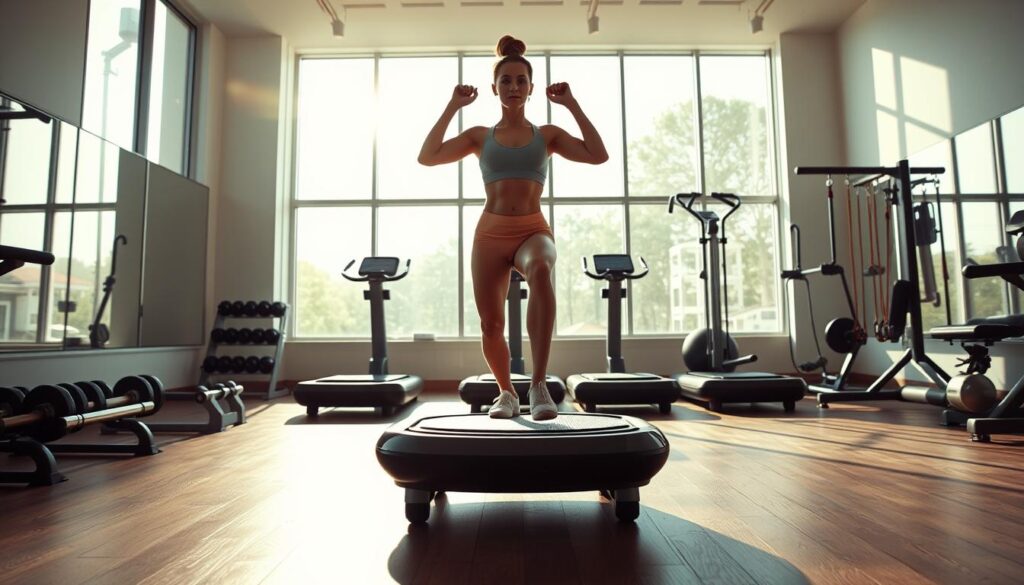
Standing Positions and Their Benefits
Start with solid stances to engage your whole body. Here are some basic moves:
| Exercise | Muscles Worked | Form Tips |
|---|---|---|
| Squats | Quads, glutes, hamstrings | Keep feet shoulder-width apart; lower until thighs are parallel. |
| Forward Lunges | Legs, core stability | Step forward 2–3 feet, bend knees to 90 degrees. |
| Calf Raises | Calf muscles | Raise heels slowly, hold for 2 seconds at the top. |
Floor-Based Exercises for Core Strength
- Plank Holds: Engage your core on the plate. Hold 30–60 seconds.
- Pike Push-Ups: Start in push-up position; lift hips while vibrating to target abs and shoulders.
Upper Body Training Options
Try these upper body exercises:
- Arm curls or flys with light bands
- Overhead presses to strengthen shoulders
Lower Body and Balance Exercises
Improve stability with these dynamic moves:
- Side lunges for outer thighs
- Single-leg balances to enhance coordination
Begin with low frequencies (20–30Hz) and increase as you get better. Mix these exercises with regular workouts for a balanced routine.
Creating an Optimal Vibration Plate Workout Routine
Creating a vibration plate workout routine is all about balance. Start with 10-minute sessions, three times a week. Then, increase to 20 minutes as you get stronger. Choose exercises that match your fitness goals, like muscle toning or endurance.
- Warm-Up: Start with 2-3 minutes of static holds like squats or planks. Use a low intensity setting (30-40Hz).
- Main Set: Do 3-5 exercises that target different muscle groups. For example, calf raises for your legs or push-ups for your upper body.
- Cool-Down: Finish with gentle stretches on the plate. This improves flexibility and circulation.
Here’s a weekly example:
| Day | Focus | Exercises |
|---|---|---|
| Monday | Strength | Squats, calf raises, lunges |
| Wednesday | Core | Planks, side bends, leg lifts |
| Friday | Recovery | Low-intensity full-body stretches |
“Consistency with proper progression is key. Increase frequency or intensity by 10% weekly to avoid plateaus.” – Dr. Emily Carter, Sports Medicine Specialist
Always warm up before using the plate and drink plenty of water. Adjust the settings: lower frequencies (20-30Hz) for recovery, higher (35-40Hz) for strength. Combine vibration training with cardio or resistance exercises for better results.
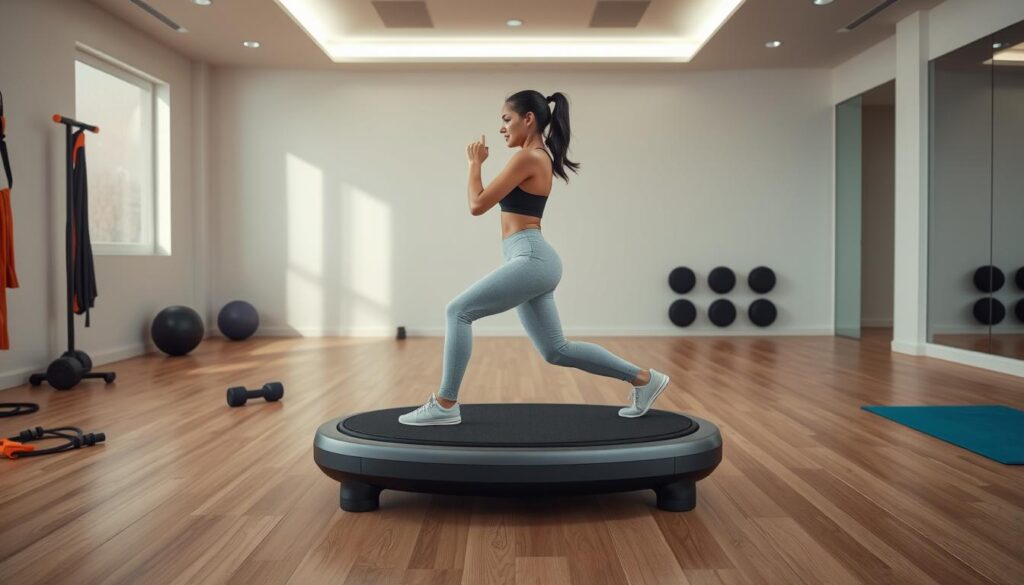
Beginners should start with 3 sessions a week, then increase to 5 as they get stronger. Mix vibration plate exercises like squats and leg presses with rest days for the best results.
Vibration Plate Therapy: Rehabilitation and Recovery Applications
Vibration plates are not just for fitness. They also help with recovery, easing soreness and improving blood flow. These vibration plate benefits make them great for overall health.
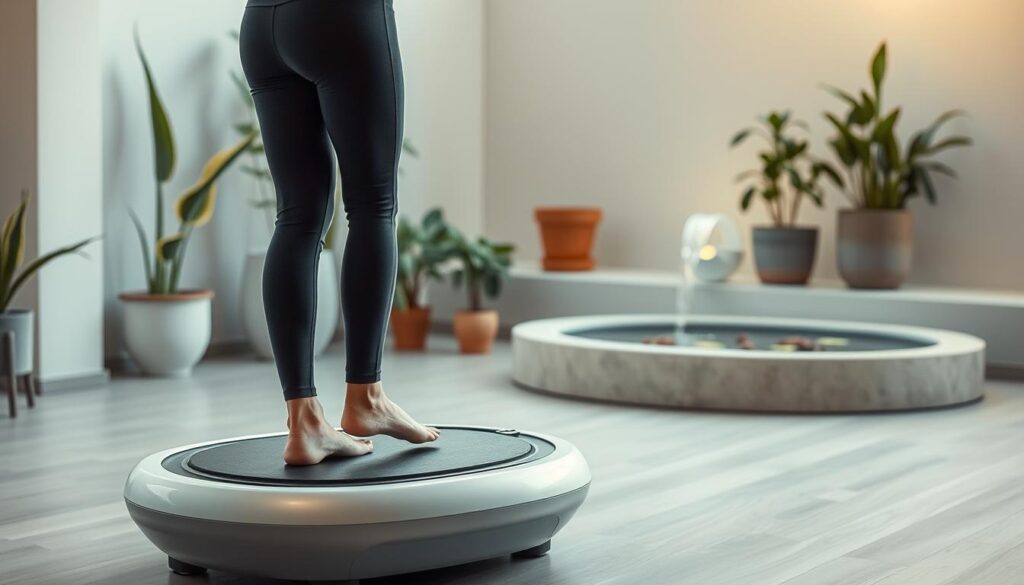
Post-Workout Recovery Benefits
Intense workouts can cause muscle damage and soreness. Vibration plate therapy helps by improving blood flow to sore muscles. Studies show it can reduce muscle soreness by up to 30%.
Athletes and gym enthusiasts use it to recover faster. This way, they can keep up with their workout routines without feeling too sore.
Injury Rehabilitation Potencial
Physical therapists use vibration plates in rehab for injuries like sprains and tendonitis. The low-frequency vibrations help muscles recover without putting strain on damaged areas. But, always get professional advice when using it for injuries.
Circulation and Lymphatic System Support
Vibration plates also help with circulation and lymphatic drainage. They improve blood flow and reduce swelling. A 2022 study found daily vibration therapy improved lymph flow.
“Vibration’s pulsating motion mimics manual lymphatic drainage techniques, making it a self-administered option for chronic conditions.”
Even though vibration plate therapy is promising, it should not replace medical care. Always talk to a healthcare provider before using it for serious conditions.
Choosing the Right Vibration Plate for Your Needs
Before you buy a what is a vibration plate, think about your goals and lifestyle. This guide will help you choose the right one. We’ll look at features, cost, and space needs.
Click here to get yours today!
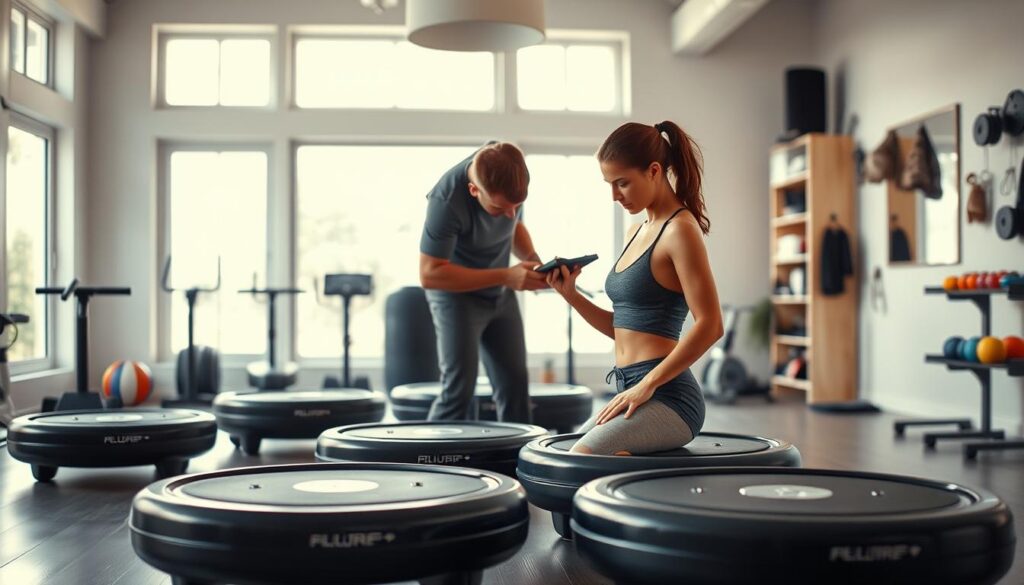
Key Features to Consider
When comparing models, look for these specs:
- Motor type: Brushless motors are more durable.
- Amplitude: Higher settings (0-12mm) are for advanced users.
- Frequency range: 2-50Hz meets most fitness needs.
- Platform size: Wider platforms (18-24 inches) fit taller users.
- Weight capacity: 300+ pounds ensures safety for all body types.
Budget vs. Premium Options
Prices vary a lot:
- Entry-level ($100-300): Basic features, great for beginners.
- Mid-range ($300-1000): Adjustable settings and quieter motors.
- Premium ($1000+): Full customization and commercial-grade build.
Read vibration plate reviews to see quality vs. cost.
Space Requirements and Portability
Ask these questions before buying:
- Does it fold or disassemble for storage?
- How loud is the motor?
- Does the base stay stable during use?
Compact models save space but might lack power. Measure your room first.
Potential Limitations and Who Should Avoid Vibration Training
Before starting with a vibration plate, it’s important to know its limits. How vibration plate works involves forces that aren’t good for everyone. Pregnant people, those with recent surgeries, or acute medical conditions like thrombosis should stay away.
- Absolute contraindications: Pacemakers, severe heart conditions, retinal detachment, hernias.
- Relative contraindications: Joint replacements, osteoporosis, epilepsy, or blood thinners need doctor’s okay.
Practical things matter too. Those with little space or who are sensitive to noise might find it hard. Using it wrong can lead to strain or injury. Always check safety tips in vibration plate reviews from trusted sources.
| Risk Factor | Description |
|---|---|
| Medical Conditions | Pregnancy, recent surgery, cardiovascular issues |
| Physical Limitations | Joint replacements, osteoporosis |
| Practical Concerns | Noise levels, space requirements |
Always talk to a doctor before starting. Look at vibration plate reviews to see safety features. Start with low frequencies and short sessions to lower risks. Proper form and medical approval are key for safe use.
Conclusion: Integrating Vibration Plates into Your Fitness Journey
Click here to get yours today.
Vibration plates are great for boosting your fitness, but they’re even better when used with other exercises. For weight loss, combining them with diet and cardio can really help. They also help with recovery, improving blood flow and reducing muscle soreness.
Before buying one, try them out at the gym or a physical therapy clinic. Start with short sessions to avoid getting too tired. It’s smart to get help from a trainer to learn how to use them right.
Studies show they can help with bone health and flexibility, but results vary. Remember, vibration plates are meant to enhance your workout, not replace it.
Look into models like the Power Plate or Hypervolt to see if they fit your needs. If you’re using them for therapy, talk to a doctor first. Always put safety first, even more so if you’re recovering from an injury or have a chronic condition.
Vibration technology is just one part of a good fitness routine. Mix it with healthy eating, rest, and different exercises for lasting results.
FAQ
What is a vibration plate?
A vibration plate is a fitness tool that sends vibrations to your muscles. This makes your workouts more effective. The vibrations help your muscles contract, which can make them stronger and more toned.
What are the benefits of using a vibration plate?
Vibration plates offer many benefits. They can improve muscle tone, increase blood flow, and help with balance and coordination. They may also help with bone density and flexibility. Plus, they can aid in recovery after workouts and support weight loss.
How do I use a vibration plate for effective workouts?
To get the most out of a vibration plate, try different exercises for different muscles. You can do standing exercises like squats and lunges, floor exercises for your core, and upper body exercises. Always keep the right form and adjust the vibration settings for each exercise.
Can vibration plates help with weight loss?
Yes, vibration plates can help with weight loss. They increase calorie burn and boost metabolism when used with diet and cardio. But remember, losing weight takes time and effort, so be patient and consistent.
What are vibration plate results I can expect?
Using a vibration plate regularly can lead to many benefits. You might see better muscle tone, improved circulation, and increased flexibility. Some effects, like better circulation, can happen quickly. But, significant weight loss or muscle growth might take longer.
How does vibration plate therapy work?
Vibration plate therapy uses vibrations to stimulate muscles, causing them to contract reflexively. This improves blood flow. It can help reduce muscle soreness after exercise, aid in recovery, and support injury rehabilitation with proper use.
What vibration plate exercises are recommended for beginners?
Beginners can start with simple exercises like squats, calf raises, and modified planks. Keep your workout sessions short, between 10-20 minutes. Gradually increase the intensity while focusing on proper form for safety and effectiveness.
Are there any specific limitations with vibration plates?
Yes, people with certain health conditions should avoid vibration plates. This includes pregnancy, recent surgeries, pacemakers, or acute injuries. Always check with a healthcare professional before starting any new workout, including vibration plates, if you have health concerns.
How do I choose the right vibration plate for my needs?
When picking a vibration plate, look at the motor power, amplitude ranges, platform size, and weight capacity. Consider your budget, whether you need a portable option, and make sure it fits your space and fitness goals.
What are the most common vibration plate reviews saying?
Vibration plate reviews often talk about improved muscle strength and flexibility. Users also like how easy they are to use for different fitness levels. Many appreciate the quick workouts, but remember, patience and consistency are key to seeing big results.
